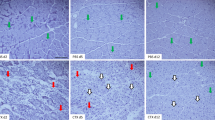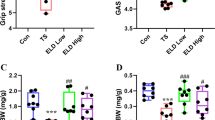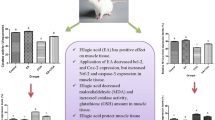Abstract
The aim of the present study was to elucidate whether the recovery from muscle injury is impaired in marginal zinc deficiency. C57BL/6 male mice were fed a marginally zinc-deficient diet (MZD: 8 mg Zn/kg diet), a zinc-adequate diet (ZA: zinc 35 mg Zn/kg diet), and a zinc-high diet (ZH: 190 mg Zn/kg diet) for 4 weeks. Muscle injury was induced in the gastrocnemius muscles using cardiotoxin. The gastrocnemius muscles of these mice were harvested at 3, 5, 7, 10, 14, and 20 days after injury. We evaluated the regeneration of the skeletal muscle with hematoxylin and eosin staining and developmental myosin heavy-chain (dMHC: implicated in regeneration) immunostaining. The rate of dMHC-positive cells was significantly low in MZD mice compared with ZA mice at 3 days after cardiotoxin injection. The peak dMHC expression was found at 3 days after injection in ZA mice, 5 days in ZH mice, and 7 days in MZD mice. These results suggest that recovery from muscle injury might be partly impaired and delayed in MZD mice. Therefore, we strongly suggest the appropriate zinc intake to prevent the impairment of skeletal muscle regeneration.





Similar content being viewed by others
Abbreviations
- RDA:
-
Recommended dietary allowance
- dMHC:
-
Developmental myosin heavy chain
- HE:
-
Hematoxylin and eosin
- TBS:
-
Tris-buffered saline
- IGF-1:
-
Insulin-like growth factor
References
Alonso JM, Edouard P, Fischetto G, Adams B, Depiesse F, Mountjoy M (2012) Determination of future prevention strategies in elite track and field: analysis of Daegu 2011 IAAF Championships injuries and illnesses surveillance. Br J Sports Med 46(7):505–514. doi:10.1136/bjsports-2012-091008
Tipton KD (2010) Nutrition for acute exercise-induced injuries. Ann Nutr Metab 57(Suppl 2):43–53. doi:10.1159/000322703
Jackson MJ (1989) Zinc in human biology. In: Mills CF (ed) Physiology of zinc, general aspects. Springer-Verlag, London, pp 1–14
Kumar P, Lal NR, Mondal AK, Mondal A, Gharami RC, Maiti A (2012) Zinc and skin: a brief summary. Dermatol Online J 18(3):1
Kawade R (2012) Zinc status and its association with the health of adolescents: a review of studies in India. Glob Health Action 5:7353. doi:10.3402/gha.v5i0.7353
Lazzerini M, Ronfani L (2012) Oral zinc for treating diarrhoea in children. Cochrane Database Syst Rev 6, CD005436. doi:10.1002/14651858
Hess SY, Lönnerdal B, Hotz C, Rivera JA, Brown KH (2009) Recent advances in knowledge of zinc nutrition and human health. Food Nutr Bull 30(1 Suppl):S5–S11
Wong CP, Ho E (2012) Zinc and its role in age-related inflammation and immune dysfunction. Mol Nutr Food Res 56(1):77–87. doi:10.1002/mnfr.201100511
Sandstead HH (1995) Is zinc deficiency a public health problem? Nutrition 11(1 Suppl):87–92
Lukaski HC (2000) Magnesium, zinc, and chromium nutriture and physical activity. Am J Clin Nutr 72(2 Suppl):585S–593S
Briefel RR, Bialostosky K, Kennedy-Stephenson J, McDowell MA, Ervin RB, Wright JD (2000) Zinc intake of the U.S. population: findings from the third National Health and Nutrition Examination Survey, 1988–1994. J Nutr 130(5S Suppl):1367S–1373S
Lukaski HC (2004) Vitamin and mineral status: effects on physical performance. Nutrition 20(7–8):632–644. doi:10.1016/j.nut.2004.04.001
Volpe SL (2007) Micronutrient requirements for athletes. Clin Sports Med 26(1):119–130. doi:10.1016/j.csm.2006.11.009
Deuster PA, Day BA, Singh A, Douglass L, Moser-Veillon PB (1989) Zinc status of highly trained women runners and untrained women. Am J Clin Nutr 49(6):1295–1301
van Rij AM, Hall MT, Dohm GL, Bray J (1986) Changes in zinc metabolism following exercise in human subjects. Biol Trace Elem Res 10:99–106. doi:10.1007/BF02795562
Anderson RA, Polansky MM, Bryden NA (1984) Acute effects on chromium, copper, zinc, and selected clinical variables in urine and serum of male runners. Biol Trace Elem Res 6:327–336. doi:10.1007/BF02989240
Lichton IJ, Miyamura JB, McNutt SW (1988) Nutritional evaluation of soldiers subsisting on meal, ready-to-eat operational rations for an extended period: body measurements, hydration, and blood nutrients. Am J Clin Nutr 48(1):30–37
Chargé SB, Rudnicki MA (2004) Cellular and molecular regulation of muscle regeneration. Physiol Rev 84(1):209–238. doi:10.1152/physrev.00019.2003
Ono Y, Gnocchi VF, Zammit PS, Nagatomi R (2009) Presenilin-1 acts via Id1 to regulate the function of muscle satellite cells in a gamma-secretase-independent manner. J Cell Sci 122(Pt 24):4427–4438. doi:10.1242/jcs.049742
Burks TN, Andres-Mateos E, Marx R, Mejias R, Van Erp C, Simmers JL, Walston JD, Ward CW, Cohn RD (2011) Losartan restores skeletal muscle remodeling and protects against disuse atrophy in sarcopenia. Sci Transl Med 3(82):82ra37. doi:10.1126/scitranslmed
Shi X, Garry DJ (2006) Muscle stem cells in development, regeneration, and disease. Genes Dev 20(13):1692–1708. doi:10.1101/gad.1419406
Cooper RN, Tajbakhsh S, Mouly V, Cossu G, Buckingham M, Butler-Browne GS (1999) In vivo satellite cell activation via Myf5 and MyoD in regenerating mouse skeletal muscle. J Cell Sci 112(Pt 17):2895–2901
Yan Z, Choi S, Liu X, Zhang M, Schageman JJ, Lee SY, Hart R, Lin L, Thurmond FA, Williams RS (2003) Highly coordinated gene regulation in mouse skeletal muscle regeneration. J Biol Chem 278(10):8826–8836. doi:10.1074/jbc.M209879200
Kirk SP, Oldham JM, Jeanplong F, Bass JJ (2004) Insulin-like growth factor-II delays early but enhances late regeneration of skeletal muscle. J Histochem Cytochem 51(12):1611–1620. doi:10.1177/002215540305101205
Talmadge RJ (2000) Myosin heavy chain isoform expression following reduced neuromuscular activity: potential regulatory mechanisms. Muscle Nerve 23(5):661–679. doi:10.1002/(SICI)1097-4598(200005)23:5<661::AID-MUS3>3.0.CO;2-J
Hotz C, Brown KH (eds) (2004) International zinc nutrition consultative group (IZiNCG) technical document #1. Assessment of the risk of zinc deficiency in populations and options for its control. Food Nutr Bull 25(1 Suppl 2):S99–S203
Micheletti A, Rossi R, Rufini S (2001) Zinc status in athletes: relation to diet and exercise. Sports Med 31(8):577–582. doi:10.2165/00007256-200131080-00002
Wood RJ (2000) Assessment of marginal zinc status in humans. J Nutr 130(5S Suppl):1350S–1354S
Park JH, Grandjean CJ, Antonson DL, Vanderhoof JA (1986) Effects of isolated zinc deficiency on the composition of skeletal muscle, liver and bone during growth in rats. J Nutr 116(4):610–617
Dørup I, Clausen T (1991) Effects of magnesium and zinc deficiencies on growth and protein synthesis in skeletal muscle and the heart. Br J Nutr 66(3):493–504. doi:10.1079/BJN19910050
Nagata M, Kayanoma M, Takahashi T, Kaneko T, Hara H (2011) Marginal zinc deficiency in pregnant rats impairs bone matrix formation and bone mineralization in their neonates. Biol Trace Elem Res 142(2):190–199. doi:10.1007/s12011-010-8760-8
Golub MS, Gershwin ME, Vijayan VK (1983) Passive avoidance performance of mice fed marginally or severely zinc deficient diets during post-embryonic brain development. Physiol Behav 30(3):409–413. doi:10.1016/0031-9384(83)90145-2
National Research Council USA (1995) Nutrient requirement of laboratory animals, 4 revisedth edn. National Academy, Washington, DC
McConnell SD, Henkin RI (1974) Altered preference for sodium chloride, anorexia, and changes in plasma and uninary zinc in rats fed a zinc-deficient diet. J Nutr 104(9):1108–1114
Shay NF, Mangian HF (2000) Neurobiology of zinc-influenced eating behavior. J Nutr 130(5S Suppl):1493S–1499S
Grider A, Mouat MF, Scrimgeour AG (2007) Consumption of a moderately Zn-deficient and Zn-supplemented diet affects soluble protein expression in rat soleus muscle. J Nutr Biochem 18(11):753–759. doi:10.1016/j.jnutbio.2006.11.013
Rodondi A, Ammann P, Ghilardi-Beuret S, Rizzoli R (2009) Zinc increases the effects of essential amino acids-whey protein supplements in frail elderly. J Nutr Health Aging 13(6):491–497. doi:10.1007/s12603-009-0099-5
Machida S, Booth FW (2004) Insulin-like growth factor 1 and muscle growth: implication for satellite cell proliferation. Proc Nutr Soc 63(2):337–340. doi:10.1079/PNS2004354
Hall AG, Kelleher SL, Lönnerdal B, Philipps AF (2005) A graded model of dietary zinc deficiency: effects on growth, insulin-like growth factor-I, and the glucose/insulin axis in weanling rats. J Pediatr Gastroenterol Nutr 41(1):72–80. doi:10.1097/01.mpg.0000166800.54085.9c
Schertzer JD, Lynch GS (2006) Comparative evaluation of IGF-I gene transfer and IGF-I protein administration for enhancing skeletal muscle regeneration after injury. Gene Ther 13(23):1657–1664. doi:10.1038/sj.gt.3302817
Kadi F (2008) Cellular and molecular mechanisms responsible for the action of testosterone on human skeletal muscle. A basis for illegal performance enhancement. Br J Pharmacol 154(3):522–528. doi:10.1038/bjp.2008.118
Prasad AS, Mantzoros CS, Beck FW, Hess JW, Brewer GJ (1996) Zinc status and serum testosterone levels of healthy adults. Nutrition 12(5):344–348. doi:10.1016/S0899-9007(96)80058-X
Kilic M (2007) Effect of fatiguing bicycle exercise on thyroid hormone and testosterone levels in sedentary males supplemented with oral zinc. Neuro Endocrinol Lett 28(5):681–685
Kilic M, Baltaci AK, Gunay M, Gökbel H, Okudan N, Cicioglu I (2006) The effect of exhaustion exercise on thyroid hormones and testosterone levels of elite athletes receiving oral zinc. Neuro Endocrinol Lett 27(1–2):247–252
Aoi W, Naito Y, Yoshikawa T (2006) Exercise and functional foods. Nutr J 5:15. doi:10.1186/1475-2891-5-15
Jówko E, Sacharuk J, Balasińska B, Ostaszewski P, Charmas M, Charmas R (2011) Green tea extract supplementation gives protection against exercise-induced oxidative damage in healthy men. Nutr Res 31(11):813–821. doi:10.1016/j.nutres
Djordjevic B, Baralic I, Kotur-Stevuljevic J, Stefanovic A, Ivanisevic J, Radivojevic N, Andjelkovic M, Dikic N (2012) Effect of astaxanthin supplementation on muscle damage and oxidative stress markers in elite young soccer players. J Sports Med Phys Fitness 52(4):382–392
Gravina L, Ruiz F, Diaz E, Lekue JA, Badiola A, Irazusta J, Gil SM (2012) Influence of nutrient intake on antioxidant capacity, muscle damage and white blood cell count in female soccer players. J Int Soc Sports Nutr 9(1):32. doi:10.1186/1550-2783-9-32
Van Loan MD, Sutherland B, Lowe NM, Turnlund JR, King JC (1999) The effects of zinc depletion on peak force and total work of knee and shoulder extensor and flexor muscles. Int J Sport Nutr 9(2):125–135
Acknowledgments
We are grateful to Dr. R. Nagatomi (Tohoku University) and Dr. K. Matsuo (Ritsumeikan University) for helpful discussions and protocol concerning histological analysis. We would like to thank Dr. K. Nakayama, Dr. T. Tsukahara, and Dr N. Matsukawa (Kyoto Institute of Nutrition and Pathology) for their assistance with the histological analyses and their critical comments.
Conflict of interest
None
Author information
Authors and Affiliations
Corresponding author
Rights and permissions
About this article
Cite this article
Jinno, N., Nagata, M. & Takahashi, T. Marginal Zinc Deficiency Negatively Affects Recovery from Muscle Injury in Mice. Biol Trace Elem Res 158, 65–72 (2014). https://doi.org/10.1007/s12011-014-9901-2
Received:
Accepted:
Published:
Issue Date:
DOI: https://doi.org/10.1007/s12011-014-9901-2




